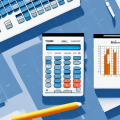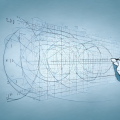Variance and standard deviation are two concepts that are closely related in statistics. Both measures are used to assess the spread of a data set and can be applied to different situations. Understanding the relationship between them can help you gain insight into the behavior of a data set.
Defining Variance and Standard Deviation
Variance and standard deviation measure the spread of data from its mean. Variance is the average of the squares of the differences between each data point and the mean. Standard deviation is the square root of the variance. The equation for variance is:
Variance = (1 / n) * ∑ (X – μ)²
Where n is the number of data points, X is each data point, and μ is the mean of the data set.
The equation for standard deviation is:
Standard Deviation = √(Variance)
Standard deviation and variance are closely related because the measure for one is the square root of the other. Standard deviation has one more step in the calculation process than variance does, so it is much easier to calculate the variance and then just take the square root of the result to find the standard deviation.
Calculating Variance and Standard Deviation
Variance and standard deviation can be calculated by hand, with a calculator, or with a spreadsheet program such as Microsoft Excel. The most common method of calculating these measures is to first calculate the mean of the data set. Once the mean is found, you can use the variance formula to calculate the variance. Finally, you can take the square root of the variance to get the standard deviation.
It is important to note that some calculators have a built-in function specifically made to calculate variance and standard deviation. These calculators are an easy and efficient way to do the calculations without needing to manually enter all of the values. In addition, many statistical software packages have built-in functions that can quickly calculate these measures.
Comparing Variance and Standard Deviation
Variance is a measure that tells us how much a data set’s values vary from its mean. Standard deviation is a measure that tells us how far on average each value in a data set is from its mean. Both measures are used to measure how far apart data points are, but they provide different information and can be used in different ways.
For example, variance can be used to compare different data sets. By comparing their variances, you can get an idea of how different two data sets are. Standard deviation, on the other hand, can be used to find outliers in a data set. Since it measures how far away each value is from its mean, it can be used to identify any values that are unusually far away from the mean.
The Use of Variance and Standard Deviation in Statistical Analysis
Variance and standard deviation are important metrics in statistical analysis. They are often used to measure the spread of data and help identify trends or patterns in data sets. When used in combination with other descriptive statistics such as mean, median, and mode, they provide powerful insights into the data set and can be used to construct models or make predictions.
For example, variance and standard deviation are important metrics for understanding the behavior of a dataset and determining if it follows the normal distribution. In addition, these metrics can be used to compare different datasets and identify outliers or extreme values.
Variance and standard deviation can also be used to measure risk in financial markets, as well as in portfolio management. By comparing the variance and standard deviation of two different stock portfolios, investors can make an informed decision about which portfolio will be more profitable over time.
Determining the Correlation Between Variance and Standard Deviation
The relationship between variance and standard deviation is often explained using a graph known as the normal distribution curve. This graph shows that as the variance increases, so does the standard deviation. This correlation between variance and standard deviation makes it easier for statisticians to visualize how far apart each data point is from its mean. It also allows them to more easily compare different datasets and quickly determine which dataset has the greatest spread.
The correlation between variance and standard deviation has several practical applications. For example, if you know the variance of a dataset, you can easily derive its standard deviation by taking the square root of the variance. This relationship makes it easier to compare datasets or identify outliers in a dataset using just one measure. It also simplifies some statistical calculations that use both measures in conjunction.
Interpreting the Results of Variance and Standard Deviation Analysis
Once you have calculated the variance and standard deviation of a dataset, it is important to understand how to interpret them in order to gain meaningful insights from your analysis. The results of your analysis should confirm or reject your hypothesis about the behavior of the data set. If your hypothesis was correct, then your analysis should also show that your data fit into a normal distribution curve with an expected variance and standard deviation.
It is also important to note that the results of your analysis may not always confirm your hypothesis about the behavior of your data set. If this is the case, then your analysis should show that your data does not fit into a normal distribution curve, or has an unexpected variance or standard deviation. You should then take some time to further examine and interpret your results in order to gain a better understanding of what may be causing these unexpected variations.
Advantages and Disadvantages of Using Variance and Standard Deviation
Using variance and standard deviation to analyze data has several advantages and disadvantages. One advantage is that these two measures provide a statistically valid assessment of how widely spread out values in a dataset are from its mean. This makes it easy to quickly compare datasets or identify outliers within a dataset.
Another advantage is that these measurements are relatively easy to calculate by hand or with a calculator or spreadsheet program. This makes it easy for anyone to analyze their data for patterns or trends without needing to learn complicated statistical formulas.
One disadvantage is that these measures do not take into account any non-numerical data or nuances in a dataset that may not be normally distributed. This means they may not always provide an accurate assessment of a dataset’s behavior when there are other factors or trends at play in addition to its numerical values.
Practical Applications of Variance and Standard Deviation
Variance and standard deviation have several practical applications in both statistics and everyday life scenarios. In statistics, they are often used to quickly compare datasets or identify outliers in data sets. They are also useful for constructing models or making predictions based on the behavior of a dataset. In addition, these metrics are often used in financial analysis to measure risk or assess portfolio performance.
In everyday life scenarios, variance and standard deviation can be used to analyze car insurance rates or gauge how much money people are willing to pay for different products or services. They can also be used in business decision making process by helping managers analyze customer preferences or market demand for different products or services.
Conclusion
Variance and standard deviation are two concepts that are closely related in statistics. They are both measures of how far away each value in a dataset is from its mean, but they provide different information and can be used differently depending on what you need to find out from your data set. Understanding the relationship between them can help you gain insight into the behavior of a data set and make decisions based on your analysis.





